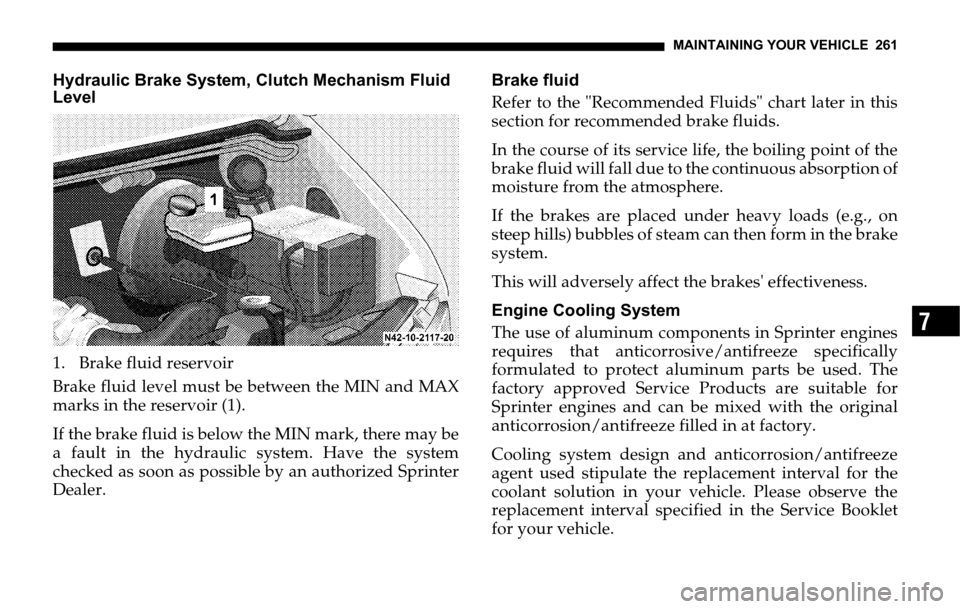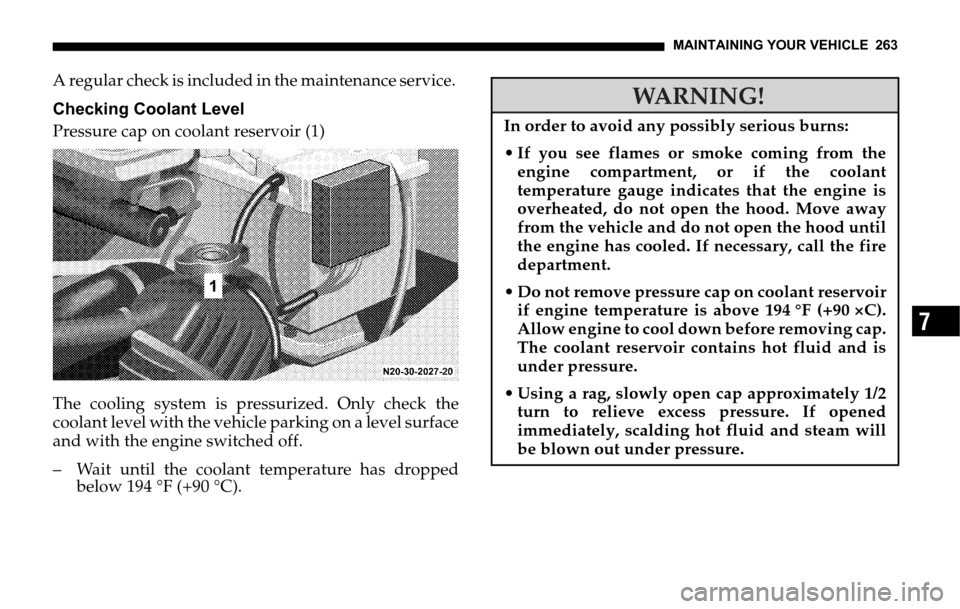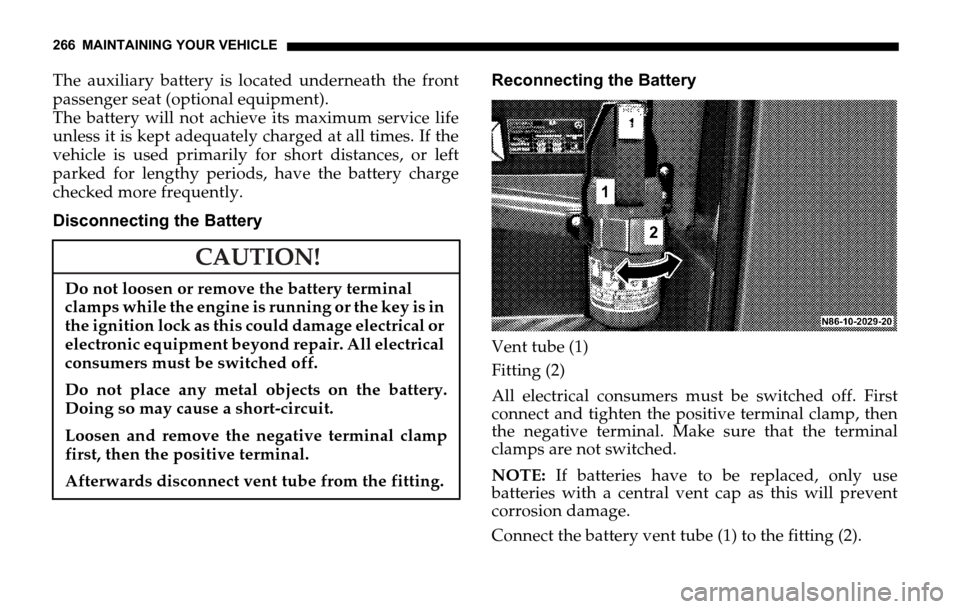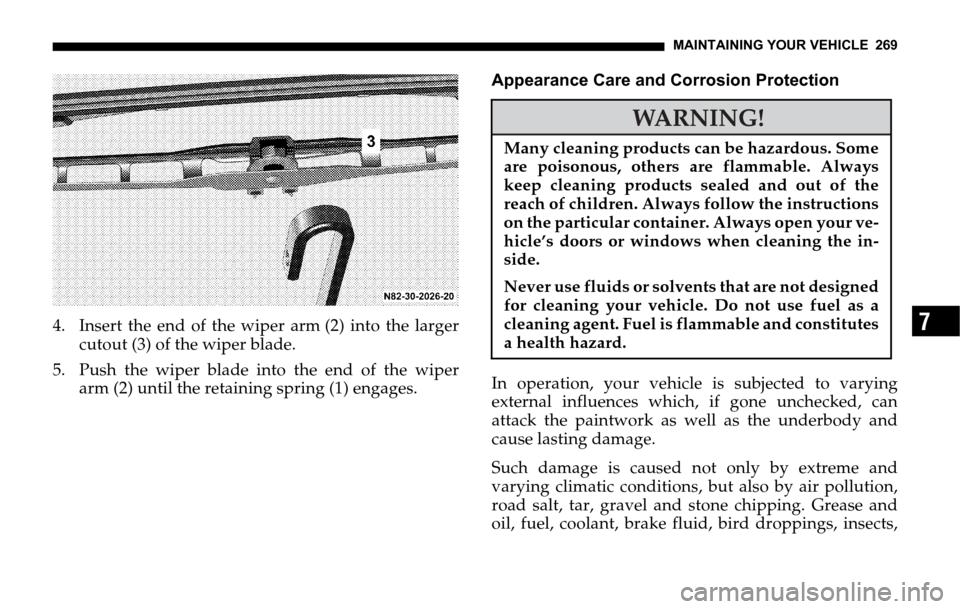DODGE SPRINTER 2006 1.G Owners Manual
Manufacturer: DODGE, Model Year: 2006, Model line: SPRINTER, Model: DODGE SPRINTER 2006 1.GPages: 330, PDF Size: 10.82 MB
Page 261 of 330

MAINTAINING YOUR VEHICLE 261
7
Hydraulic Brake System, Clutch Mechanism Fluid
Level
1. Brake fluid reservoir
Brake fluid level must be between the MIN and MAX
marks in the reservoir (1).
If the brake fluid is below the MIN mark, there may be
a fault in the hydraulic system. Have the system
checked as soon as possible by an authorized Sprinter
Dealer.Brake fluid
Refer to the "Recommended Fluids" chart later in this
section for recommended brake fluids.
In the course of its service life, the boiling point of the
brake fluid will fall due to the continuous absorption of
moisture from the atmosphere.
If the brakes are placed under heavy loads (e.g., on
steep hills) bubbles of steam can then form in the brake
system.
This will adversely affect the brakes' effectiveness.
Engine Cooling System
The use of aluminum components in Sprinter engines
requires that anticorrosive/antifreeze specifically
formulated to protect aluminum parts be used. The
factory approved Service Products are suitable for
Sprinter engines and can be mixed with the original
anticorrosion/antifreeze filled in at factory.
Cooling system design and anticorrosion/antifreeze
agent used stipulate the replacement interval for the
coolant solution in your vehicle. Please observe the
replacement interval specified in the Service Booklet
for your vehicle.
Page 262 of 330

262 MAINTAINING YOUR VEHICLE
Failure to use MB 325.0 anticorrosion/antifreeze and/or
equivalent to DaimlerChrysler material standard MS-
9769 and/or adhere to the specified replacement interval
may result in a significantly shortened service life.
For coolant composition and water quality, contact
your authorized Sprinter Dealer.
Engine Coolant
The coolant is a mixture of water and a corrosion
inhibitor/antifreeze additive. Within the cooling
system, the corrosion inhibitor/antifreeze ensures
anti-corrosion protection
antifreeze protection
a higher boiling point.
The coolant added in the factory ensures adequate
antifreeze and anti-corrosion protection.
Refer to the "Recommended Fluids" chart for coolant
recommendations.
For reasons of anti-corrosion protection and to increase
the boiling point, the coolant added to the cooling
system is designed for all year round operation – even
in countries with high prevailing temperatures.Have the coolant renewed at least every 15 years or
after 160,000 miles.
When the coolant is renewed, the new coolant should
contain 50% antifreeze/corrosion inhibitor by volume.
This corresponds to antifreeze protection down to -
37 °C/-35°F.
Do not exceed a proportion of about 55 % by volume
(antifreeze protection down to about -45 °C/-49 °F) as
the heat dissipation properties then deteriorate.
In the event of coolant loss, do not add water only, but
sufficient antifreeze/corrosion inhibitor to maintain
the correct concentration.
The water in the coolant must satisfy certain
requirements. These are often met by tap supply
drinking water.
The water must be specially prepared if the water
quality does not come up to the required standards.
Have the corrosion inhibitor/antifreeze concentration
in the coolant checked at the outset of winter,
respectively once a year in countries with high
prevailing temperatures.
Page 263 of 330

MAINTAINING YOUR VEHICLE 263
7
A regular check is included in the maintenance service.
Checking Coolant Level
Pressure cap on coolant reservoir (1)
The cooling system is pressurized. Only check the
coolant level with the vehicle parking on a level surface
and with the engine switched off.
– Wait until the coolant temperature has dropped
below 194 °F (+90 °C).
WARNING!
In order to avoid any possibly serious burns:
If you see flames or smoke coming from the
engine compartment, or if the coolant
temperature gauge indicates that the engine is
overheated, do not open the hood. Move away
from the vehicle and do not open the hood until
the engine has cooled. If necessary, call the fire
department.
Do not remove pressure cap on coolant reservoir
if engine temperature is above 194 °F (+90 ×C).
Allow engine to cool down before removing cap.
The coolant reservoir contains hot fluid and is
under pressure.
Using a rag, slowly open cap approximately 1/2
turn to relieve excess pressure. If opened
immediately, scalding hot fluid and steam will
be blown out under pressure.
Page 264 of 330

264 MAINTAINING YOUR VEHICLE
Open the hood.
At first, only turn the pressure cap on coolant
reservoir to the first detent to release the pressure
from the cooling system. Only then should the
pressure cap be removed completely.
To add coolant:
If the engine is cold:
Add coolant until the coolant level reaches the base
area which is visible through the filler opening (area
moistened).If the engine is already at its regular operating
temperature:
Add coolant until the coolant level is about 0.6 inch
(1.5 cm) above the base area which is visible
through the filler opening.
Replace and tighten the pressure cap on coolant
reservoir.
If a large quantity of coolant has been lost, or if smaller
amounts are lost at regular intervals, have the engine
cooling system examined by an authorized Sprinter
Dealer.
For coolant composition and water quality, contact
your Sprinter Dealer.
WARNING!
Do not spill antifreeze on hot engine parts. Anti-
freeze contains ethylene glycol which may burn
if it comes into contact with hot engine parts.
Check coolant level only with the engine
switched off and the key in position 0 in the
ignition lock.
Page 265 of 330

MAINTAINING YOUR VEHICLE 265
7
WINTER OPERATION
Have your vehicle winterized by an authorized
Sprinter Dealer before the onset of winter.
Have the engine oil changed, if the engine oil filled
is not approved for winter use.
Coolant: antifreeze/anti-corrosion concentration in
the coolant checked.
Windshield washer system and headlamp cleaning
system (optional): add windshield washer fluid
"winter wash" to the water, depending on ambient
temperatures.
Battery: the battery will lose capacity as
temperatures drop. Only a well-charged battery will
ensure reliable engine starting even at low outside
temperatures.
Tires: fit M+S radial tires with a minimum tread
depth of approximately 1/6 in (4 mm) on all wheels
for the winter season.BATTERIES
The standard battery is located in the engine
compartment.
WARNING!
Failure to follow these instructions can result in
severe personal injuries and death.
Never lean over batteries while connecting, you
might get injured, if the battery explodes.
Battery fluid contains sulfuric acid. Do not allow
this fluid to come in contact with eyes, skin or
clothing. In case it does, immediately flush
affected area with water and seek medical help if
necessary.
A battery will also produce hydrogen gas, which
is flammable and explosive. Keep flames or
sparks away from battery, avoid improper
connection of jumper cables, smoking etc.
Use only impact-resistant batteries with a central
gas release cover to prevent corrosion damage and
to prevent occupants from caustic burns in the
event of an accident.
Page 266 of 330

266 MAINTAINING YOUR VEHICLE
The auxiliary battery is located underneath the front
passenger seat (optional equipment).
The battery will not achieve its maximum service life
unless it is kept adequately charged at all times. If the
vehicle is used primarily for short distances, or left
parked for lengthy periods, have the battery charge
checked more frequently.
Disconnecting the BatteryReconnecting the Battery
Vent tube (1)
Fitting (2)
All electrical consumers must be switched off. First
connect and tighten the positive terminal clamp, then
the negative terminal. Make sure that the terminal
clamps are not switched.
NOTE: If batteries have to be replaced, only use
batteries with a central vent cap as this will prevent
corrosion damage.
Connect the battery vent tube (1) to the fitting (2).
CAUTION!
Do not loosen or remove the battery terminal
clamps while the engine is running or the key is in
the ignition lock as this could damage electrical or
electronic equipment beyond repair. All electrical
consumers must be switched off.
Do not place any metal objects on the battery.
Doing so may cause a short-circuit.
Loosen and remove the negative terminal clamp
first, then the positive terminal.
Afterwards disconnect vent tube from the fitting.
Page 267 of 330

MAINTAINING YOUR VEHICLE 267
7
Charging the Battery
Disconnect the battery before charging it with a battery
charger.
Comply with the operating instructions for the battery
charger.
To ensure that the battery is disposed of in an
environmentally responsible manner, it should only be
replaced by an authorized Sprinter Dealer.
Batteries contain material that can harm the
environment with improper disposal.
Large 12 volt storage batteries contain lead.
Recycling of batteries is the preferred method of
disposal.
Many states require sellers of batteries to accept old
batteries for recycling.
WARNING!
Use only refrigerants and compressor lubricants
approved by the manufacturer for your air
conditioning system. Some unapproved
refrigerants are flammable and can explode,
injuring you. Other unapproved refrigerants or
lubricants can cause the system to fail, requiring
costly repairs. Refer to Section 3 of the Warranty
Information Book for additional warranty
information.
The air conditioning system contains refrigerant
under high pressure. To avoid risk of personal
injury or damage to the system, adding
refrigerant or any repair requiring lines to be
disconnected should be done by an experienced
repairman.
Page 268 of 330

268 MAINTAINING YOUR VEHICLE
Refrigerant Recovery and Recycling
R-134a Air Conditioning Refrigerant is a
hydrofluorocarbon (HFC) that is endorsed by the
Environmental Protection Agency and is an ozone-
saving product. However, the manufacturer
recommends that air conditioning service be
performed by dealers or other service facilities using
recovery and recycling equipment.REPLACING WIPER BLADES
1. Fold over the wiper arm (2) and place the wiper
blade crosswise.
2. Press the retaining spring (1) and push the wiper
blade out of the end of the wiper arm (2).
3. Remove the wiper blade.
Page 269 of 330

MAINTAINING YOUR VEHICLE 269
74. Insert the end of the wiper arm (2) into the larger
cutout (3) of the wiper blade.
5. Push the wiper blade into the end of the wiper
arm (2) until the retaining spring (1) engages.Appearance Care and Corrosion Protection
In operation, your vehicle is subjected to varying
external influences which, if gone unchecked, can
attack the paintwork as well as the underbody and
cause lasting damage.
Such damage is caused not only by extreme and
varying climatic conditions, but also by air pollution,
road salt, tar, gravel and stone chipping. Grease and
oil, fuel, coolant, brake fluid, bird droppings, insects,
WARNING!
Many cleaning products can be hazardous. Some
are poisonous, others are flammable. Always
keep cleaning products sealed and out of the
reach of children. Always follow the instructions
on the particular container. Always open your ve-
hicle’s doors or windows when cleaning the in-
side.
Never use fluids or solvents that are not designed
for cleaning your vehicle. Do not use fuel as a
cleaning agent. Fuel is flammable and constitutes
a health hazard.
Page 270 of 330

270 MAINTAINING YOUR VEHICLE
tree resins etc. should be removed immediately to
avoid paint damage. Frequent washing reduces and/
or eliminates the aggressiveness and potency of the
above adverse influences.
More frequent washings are necessary to deal with
unfavorable conditions; for example operation near the
ocean, in industrial areas (smoke, exhaust emissions),
or during the winter months.
You should check your vehicle from time to time for
stone chipping or other damage. Any damage should
be repaired as soon as possible to prevent the start of
corrosion.
In doing so, do not neglect the underside of the vehicle.
A prerequisite for a thorough check is a washing of the
underbody followed by a thorough inspection.
Damaged areas need to be undercoated again.
Your vehicle has been treated at the factory with a wax-
base rustproofing in the body cavities which will last
for the lifetime of the vehicle. Post-production
treatment is neither necessary nor recommended by
DaimlerChrysler Corporation.Because of the possibility of incompatibility between
materials used in the production process and others
applied later.
Scratches, corrosive deposits, corrosion or damage due
to negligent or incorrect care cannot always be
removed or repaired with car-care products. In such
cases it is best to seek aid by your authorized Sprinter
Dealer.
The following topics deal with the cleaning and care of
your vehicle and give important "how-to" information
as well as references to car-care products.
WARNING!
Never use openings in the bodywork as steps.
You could otherwise damage the vehicle and it
could lead to an accident.
CAUTION!
Do not use abrasive or strong cleaning materials
such as steel wool or scouring powder, which will
scratch metal and painted surfaces.